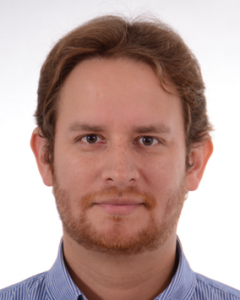Events
Predicting the Microstructure Stability in Photovoltaic Polymer-Fullerene Blends Using Figure of Merit*
November 1, 2017 at 4:30pm/35-520
Jose Dario Perea
Friedrich Alexander Universität (Germany), Engineering, Visiting Student in the Aspuru-Guzik Group at Harvard

A theoretical understanding of the micro-structure of organic semiconducting polymers and blends is vital to further advance the optoelectronic device performance of organic electronics. We outline the theoretical framework of a combined numerical approach based on polymeric solution theory to study the microstructure of polymer-small-molecule blends. We feed the results of ab initio density functional theory quantum chemistry calculations into an artificial neural network for the determination of solubility parameters. These solubility parameters are used to calculate Flory−Huggings intermolecular parameters. We further show that the theoretical values are in line with experimentally determined data. On the basis of the Flory−Huggings parameters, we establish a figure of merit as a relative metric for assessing the phase diagrams of organic semiconducting blends in thin films. This is demonstrated for polymer-fullerene blend films on the basis of the prototypical polymers poly(3-hexylthiophene-2,5-diyl) (P3HT) and poly[(5,6-difluoro-2,1,3-benzothiadiazol-4,7-diyl)-alt-(3,3-di(2-octyldodecyl)-2,2,5,2;5,2-quaterthiophen-5,5-diyl)] (PffBT4T-2OD). After confirming the applicability of our model with a broader range of materials and differences in molecular weight, we suggest that this combined model should be able to inform design criteria and processing guidelines for existing and new high performance semiconducting blends for organic electronics applications with ideal and stable solid state morphology.
Jose Dario Perea is third-year PhD student of Engineering at Friedrich Alexander Universität (Germany) and currently a visiting student at Harvard University, Department of Chemistry and Chemical Biology working in Aspuru-Guzik´s group. Perea’s research focuses on the determination of thermodynamic, electric and dynamic properties based in different theoretical models for the improvement and understanding of the organic solar cells. He has collaborated with research groups in several universities including the Max Plank Institute of Colloids and Interfaces (Germany), Pannonia University (Hungary), and Harvard University. He is co-organizer of an international conference on Next Generation Solar Energy, to be held in Dec, 2017 in Cali – Colombia (www.ngse.info). He has published in several journals, including Nature Comm. and an author chapter book by Wiley.
*This talk is part of the Perovskites Seminar Series organized by Juan-Pablo Correa-Baena from MIT’s PV Lab and sponsored by the Center for Excitonics. For more info contact Juan-Pablo: jpcorrea@mit.edu






